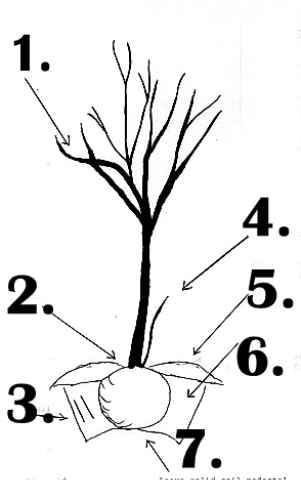|
Knowledgeable Staff - Quality Products |
|
||
|
|
|
|
||
|
|
|
|
|
Knowledgeable Staff - Quality Products |
|
||
|
|
|
|
||
|
|
|
|
 |
Trees usually are the most valuable addition
to your landscape. Careful planting will reward you with beauty,
shade, and fragrance. It is our hope that this brochure will
touch upon the basic planting and management of your trees.
|
|
When choosing a tree for your property,
the main factor should be climate i.e. winter hardiness and heat tolerance.
An upfront given: a tree should do perfectly well and thrive in a
climate that exceeds neither of these two climate extremes. Soil
(pH), drainage, moisture, and sun, also play a major role in your tree's
overall health life span.
|
|
Location is EXTREMELY important. A tree needs space to grow and flourish. Try to step into the future 15 years ahead, and capture the size of the tree in your mind. Will the area withstand the tree's growth: i.e. house, pool, deck, electrical lines, street signs, etc.
Note: Wind can damage a tree. Cold winter winds, and summer winds are deadly to evergreens. Be cautious as to where you choose to plant these trees. If you must plant a tree in an area that gets a lot of wind, be sure that the particular tree will tolerate it.
Soil: All soils are composed of three basic kinds of particles – very small particles of rock called clay, larger gritty particles of gravel and sand, and medium sized silt particles. Loam is a balanced combination of all three components mixed with organic matter. These particles constitute about half of the volume of an ideal soil. The remaining volume is made up of spaces or pores; which trap water and air. Some of these pores are large enough to allow water to drain away and bring air into the soil. These balances are small enough to hold water against the pull of gravity, storing it and making it available to trees on rainless days.
Compacted soil (like squeezing a fresh
piece of bread making it a fraction of its normal size) is NOT a good choice
of location for a tree. Compacted soil has little area for water
and air. As it happens many times, not all soils have all three of these
necessities to help maintain a healthy tree. But if your choice area
for a tree has all three, you are on the road to success!
|
|
| Shade | Ornamental | Evergreens |
| Ginkgo | Dogwood | Norway Spruce |
| Zelkova | Magnolia | White Pine |
| Oaks - Pin and Willow | Crabapple | Canadian Hemlock |
| Maple - Red & Sugar | Cherry | Leyland Cypress |
| Lacebark Elm | Carolina Silverbell | Hollies |
| Red Bud | ||
| Japanese Maple | ||
| Styrax |
|
|
Your tree will come in one of two forms: Balled and Burlapped (B&B) or Container Grown. Container plants or balled and burlapped plants may be planted at any time the ground is not frozen, except very hot weather.
Planting Sensitive Species: Some
species, are sensitive to transplanting, and should be purchased in containers
and left for a period of time to pass, so they can adjust to transplant
shock. Examples include: Leyland Cypress, Black Gum, Japanese Pagoda,
and Foster-Holly.
 |
| 1. Prune rubbing or
cross branches. Do not stake trunk unless necessary. Remove
tags and labels.
2. Cut away all balling ropes. Remove top of wire basket or all, if root-ball is solid, not crumbling. 3. Widen and score hole wall. If container grown, remove container, remove any broken or damaged roots, and cut circling roots. If field grown, remove as much burlap as possible, while keeping root-ball intact. 4. Prune suckers. 2” – 3” well drained mulch, such as Virginia Fines Pine mulch, kept away from trunk. 5. Backfill containing up to 1/3 organic matter. 6. Partially backfill, water to settle soil, finish backfilling. 7. Leave solid soil pedestal – do not dig deeper than ball depth. *Dig hole 2-3 times root ball width. |